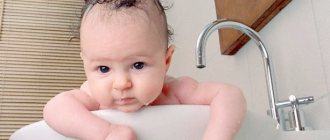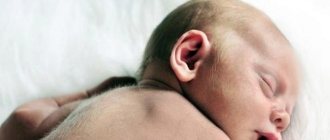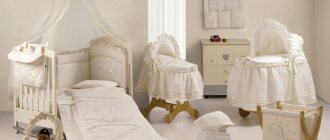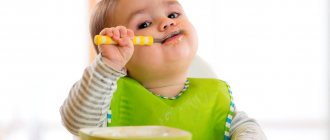A child, while in the womb, feels pressure from the walls of the uterus throughout the entire period of gestation, which after birth has been successfully replaced by swaddling for centuries. It is believed that a newborn whose movements are limited using fabric or other modern devices feels more protected, which has a positive effect on the quality of his sleep.
However, if previously no one questioned the need and importance of swaddling, now not every mother resorts to this procedure.
Choosing the right diaper
When choosing a changing kit, first of all look at the weight and height of the newborn. The following tips will help you navigate the situation:
- Buy several different copies to decide which ones are more convenient to use.
- Large square diapers 120x120 centimeters will probably come in handy . At first, you can wrap your baby head and shoulders in them, later they will come in handy during a doctor’s examination, on the road, or as a sheet for the crib.
- Cloth 100x100 centimeters is recommended for swaddling children up to 3–4 months .
- Previously, the most popular diapers were 80x95, 80x120 centimeters.
- For premature babies, diapers with a length of 70 centimeters .
- Standard diapers for the classical method are rectangular in shape .
Typically, the set should consist of half diapers made of thin fabric and half warm ones.
- The most common lightweight fabrics are cambric, kulirka and chintz. Batiste models tear quickly, but are ideal for air permeability and are suitable for summer and hot weather. The cooler shrinks a lot. Calico fabric for children is the most popular.
- Warm fabrics include knitwear, flannel, and footer. The advantage of knitted models is the ability to take any shape, the baby can move his arms and legs. Classic flannel diapers are made of pure cotton and are characterized by the ability to perfectly absorb moisture. Footer is the warmest material; it is a winter option for babies. Models made from it must be large.
Important ! In the first days, a newborn is capable of soiling clothes up to 20 times a day . If you are not going to use disposable diapers, the number of diapers needs to be doubled, since some of them will be constantly in the wash. A diaper folded in four is also used as a headrest. Plus you need gauze diapers.
Transforming models are very convenient, in which the baby’s legs are placed in a pocket, and the body is wrapped in the edges on which Velcro is located.
Swaddling methods
At what age should a newborn baby be swaddled?
Schemes for how to swaddle a baby can be different. They depend on swaddling methods that ensure a more or less free position for the baby:
- Tight. This is an old method of nursing swaddling in the maternity hospital, which is now rarely used. It provides for the position of the newborn when his arms and legs are pressed tightly. Currently, nurses prefer a looser method of swaddling;

Tight swaddling
- Wide (closed). The baby is completely wrapped in a diaper, but is provided with relative freedom of movement, since the arms and legs are not pressed when swaddling;
- Wide (open). With this method, the upper body along with the arms remains free;
- With your head. The method is similar to the closed one, but the cap is not put on the child separately, but is also made from a diaper. Used only in the first days and weeks after birth;

The baby was swaddled with his head
- An envelope. This method is used to wrap the baby in a blanket when going for a walk with him.
Types of swaddling
Even many experienced mothers do not know how many types of swaddling there are. Main methods: tight, loose, wide . From birth, the baby's head is wrapped in linen; later, only the legs are swaddled.
Swaddled in a blanket, envelopes, slings, sleeping bags. Modern models have bright pictures, which makes the toddler’s appearance funny and aesthetically pleasing. Whether you have a girl or a boy, there are any options.
Each type requires skill. You can train on dolls, toys, or learn by wrapping an even roll of blanket in fabric. It is advisable to master all the methods before the baby is born, during pregnancy. Inept actions can scare the baby or accidentally injure him. Once you learn the algorithm of actions, it will be easier in practice.
Are you planning to swaddle your baby?
- Yes, free version 48%, 147 votes
147 votes 48%147 votes - 48% of all votes
- Yes, tight, like our grandmothers 33%, 102 votes
102 votes 33%
102 votes - 33% of all votes
- No, I think this is wrong 19%, 60 votes
60 votes 19%
60 votes - 19% of all votes
Total votes: 309
16.05.2018
×
You or from your IP have already voted.
Before wrapping the baby in cloth, you need to put on a diaper and a vest. Which diaper to use, gauze or disposable diaper, is up to the mother to choose. Many pediatricians advise leaving the baby's head uncovered.
There is a well-known phrase from Dr. Komarovsky that it is better to put a cap on a grandmother than on a baby.
Reasons for swaddling
The tradition of swaddling a child began many years ago, not simply because babies had no clothes other than diapers. In addition, it was noticed that the baby feels more comfortable in them, calms down faster and wakes up less often.
During the first two months after birth, the infant craves the sensations it enjoyed in the womb. The large number of external stimuli that he receives in his new environment overloads his vulnerable nervous system and forces the baby to react in the only ways known to him: screaming and crying.
Although in Western countries it is believed that crying is a natural companion of a baby’s life, which parents just need to come to terms with. There are ways to significantly reduce your child's anxiety.
Important! Swaddling a baby, carrying him in your arms, rocking him to sleep are old methods that are aimed at satisfying the child’s desires, helping him calm down, feel safe and fall asleep.
Classic tight version
Swaddling a newborn with a “soldier” assumes that the baby’s arms will be straight along the body. The legs in this position are straightened and tightly wrapped in cloth. There are several ways: swaddling with the head or just the torso.
First method (with the head)
- This method requires two diapers. Spread the first one horizontally at the level of the baby’s shoulders. Place the second one on top in a diamond shape and fold the corner under the back of the baby’s head.
- Place the baby in the center so that the edge of the top panel can be wrapped around the head. Tuck the edges of the fabric and place tightly around the baby's forehead and temples.
- Bend the baby's arm towards your chest, wrap it in a diaper, bringing the edge first under the armpit, then towards the legs.
The fabric should fit snugly around the body, but not too tight so that the baby can breathe freely. We repeat the same action on the other side. - Now we wrap the child with the second cloth, the direction of the edge of the fabric is from the shoulder to the opposite arm, it is placed under the back. We wrap the second half of the body in the same way.
- Wrap the bottom end of the diaper around the baby's legs, secure the ends by tucking them into the folded edge.
You cannot use pins of any kind; if necessary, it is better to use tape. A strong child is able to free himself and grab a dangerous object.
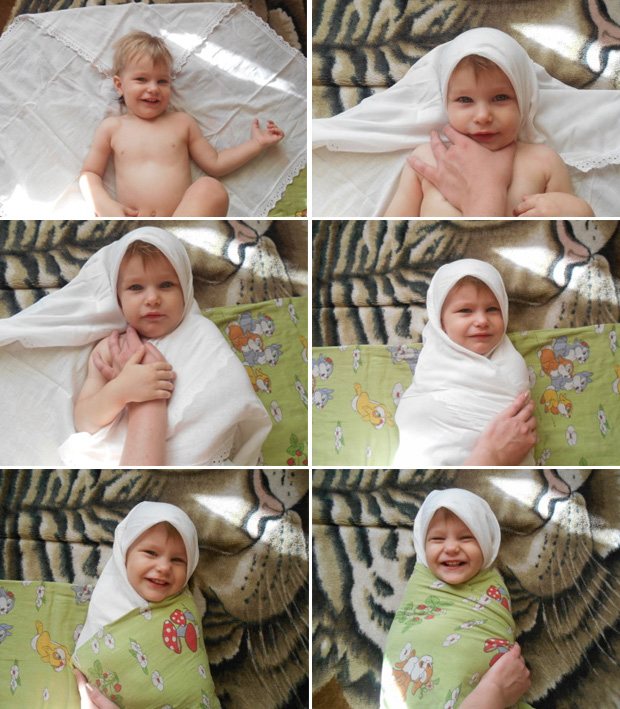
Second method (body only)
Suitable after swimming. It is not very convenient to pull on baby onesies and blouses; it is easier to wrap the baby in a large diaper.
- To do this, the canvas is arranged in the form of a diamond, the upper edge is folded inward.
- You need to lay the baby closer to the top, fold the edges of the fabric, clasping the baby’s shoulders.
- Wrap the right edge of the diaper around the left side of the baby's body and place it under the back.
- Raise the bottom edge up, stretch the fabric and wrap it around the baby’s shoulder. Wrap the baby's body with the left hand and secure the tip of the diaper.
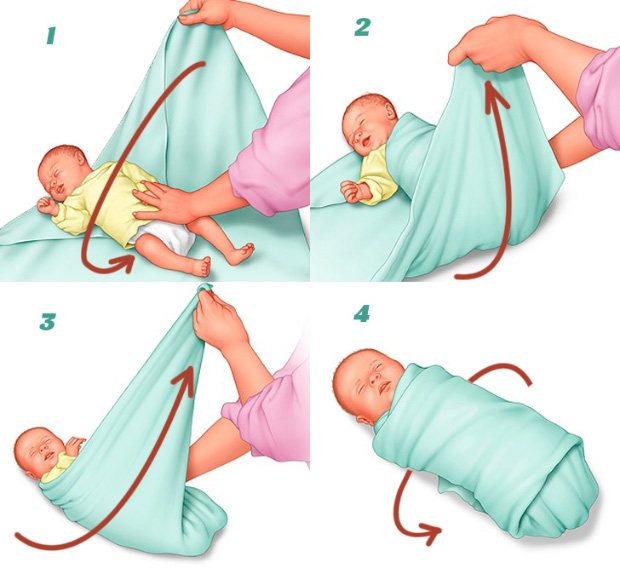
This method raises many objections; modern pediatricians do not recommend it. Although the child’s sleep with this method is sound, constant stay in a static position interferes with natural development, and the tightly stretched tissue impairs blood circulation.
It is a myth that crooked legs can be corrected using this method. A child in several layers of fabric quickly overheats, and colic may occur.
The best option: use loose or wide swaddling.
Free option
Swaddling this way can be done in different ways.
Basic principle: the baby’s arms and legs are given some freedom. You can wrap the baby, leaving the arms open, or you can use the so-called Australian method. Here are the step-by-step instructions:
- Lay out a large diaper.
- Fold the top edge inward about 10 centimeters. Place your child in the center with his shoulders on the folded edge of the material.
- Place the baby's hand in the resulting space formed by the edge of the diaper. Pass the end of the fabric under the armpit of the opposite arm and place it behind the back.
- Repeat on the other side.
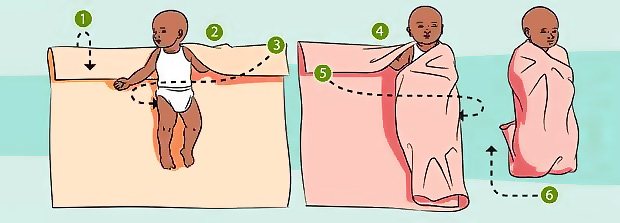
If you did everything correctly, the baby’s fists will be located at the level of the mouth, and the baby’s hands can move in the resulting pocket. The baby will not be able to pull out his hands and will not frighten himself with an awkward movement.
You can fold a large diaper diagonally and spread it with the blunt end down. The baby is placed so that his head is slightly above the edge of the diaper. Wrap the ends of the resulting triangle diagonally around the baby, securing the lower end under the chin.
How to swaddle a newborn baby in the summer?
In hot weather, it is best to use the free swaddling . With this method, the baby, while swaddling, is positioned on the diaper so that his arms remain above the edge of the diaper. We wrap the diaper in the same way as with simple swaddling. Thus, the newborn baby's arms remain open. Or, you can use ready-made envelopes in which the baby’s legs are fixed and the arms are free.
If your swaddled baby shows obvious signs of anxiety and cannot calm down even in your arms, check whether you swaddled him too tightly and whether there are folds in the swaddle that are interfering with him. It is very important that the baby feels comfortable. The recommended air temperature in a room with a newborn wrapped in a diaper should be about twenty degrees.
Wide variety
The fact that tight swaddling leads to hip dysplasia, for example, with a breech presentation of the fetus, was noticed back in the Middle Ages.
Currently, it is recommended that a newborn stay in the frog position , when the legs are widely spread apart.

For the classic version of this method, two diapers are used.
- One is folded in two or four times to make a triangular diaper (in the shape of a scarf).
- It is placed under the baby’s lower back, the sharp corners of the triangle are located on the sides, and the blunt corner is passed between the legs.
- The ends of the diaper are wrapped around the baby's body and secured.
- The baby in the diaper is placed on the second diaper so that it covers the kidney area.
- The upper ends of the fabric need to be wrapped alternately around the baby’s body and secured, the lower edge should be raised to the tummy.
- Wrap the lower edges of the material around the baby's lower back and secure the ends.

Selection of diapers
Diapers are made from various materials, the main characteristic of which is their 100% naturalness. When choosing suitable fabrics, consider the time of year and weather. For hot days, products made from chintz and calico are suitable, for cold times - from flannel, flannel.
Often, when it is cold, two diapers are used: a lower calico and an upper flannel. You can purchase more modern options: Velcro, zippers, envelopes.
Important! The number of diapers is determined by the time of use: at night or throughout the day.
Swaddling the legs
After the baby has passed the age of a newborn, only the legs can be swaddled.
- To do this, a horizontally located canvas is placed under the baby’s shoulder blades, and its edges are alternately placed under the little one’s arms.
- The upper ends are fixed, and the lower part is twisted under the baby’s heels, like a candy wrapper. Legs should be straight.
- The edge of the fabric is then straightened and secured by wrapping it around the child's hips.
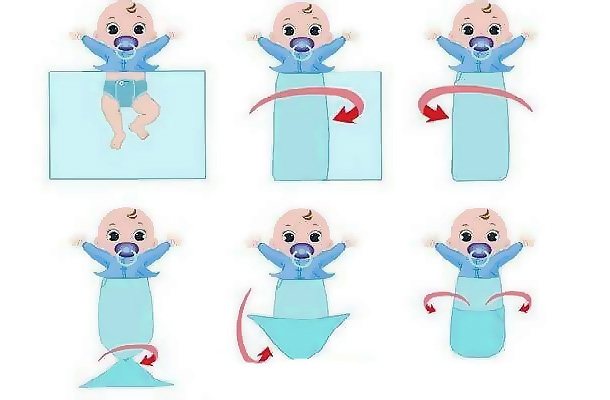
How to swaddle in a blanket for a walk
When going for a walk, many people use discharge envelopes and overalls. But if you need to go out on a frosty day, use a baby blanket. If everything is done correctly, the child will definitely not freeze. And putting it on will be easier than putting on a bunch of clothes.
Proceed step by step:
- Put on a hat and a blouse for the baby, wrap it in a warm cloth.
- First, place the securing tape under the blanket laid out in a diamond pattern.
- Then put the baby down. Fold the right edge diagonally and pass it under the left handle.
- Lift the bottom edge, straighten it in the area of the legs.
- Wrap the left edge of the blanket around the child's torso and secure it with tape in several layers over the entire surface.
In this video, the author explains in detail and shows the whole process using a live example.
Diagnosis of dysplasia
A timely, careful examination will help to make a correct diagnosis of the baby. If the child lies on his back, his legs are always bent at the knees and slightly spread apart. In a healthy baby, with a little pressure on them, the legs easily spread and lie on the table.
Read also…. Why does my tailbone hurt?
The baby is then turned onto his tummy on the changing table. Upon careful examination of dysplasia, the asymmetry of the folds under the buttocks and in the knee area is striking. The skin fold on the side where there is dysplasia and subluxation or dislocation will be located higher than on the healthy side. There may also be an additional fold.
The leg on the affected side may be slightly shortened, which is also associated with subluxation of the femoral head. However, all these changes are typical only for a situation where the pathology is one-sided. If it affects both joints at the same time, additional studies will help make the correct diagnosis:
- Ultrasound;
- X-ray of joints.
Doctors give greater preference to the ultrasound method in children, since it is not as dangerous as X-ray - the baby is not exposed to dangerous radiation. In addition, it allows you to examine the condition of the cartilage, tendons, and joint capsule.

